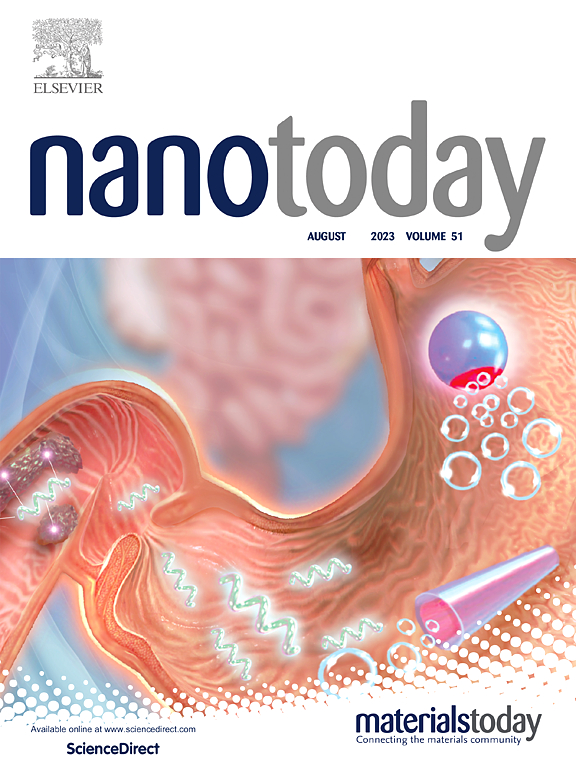Photo-driven bacterial motor for tumor-targeted deep penetration and destruction while reducing hepatotoxicity
IF 13.2
1区 材料科学
Q1 CHEMISTRY, MULTIDISCIPLINARY
引用次数: 0
Abstract
Live bacteria-based therapeutics show immense promise in cancer treatment due to their combined tumor-killing and immune-modulating functions. However, their clinical application is limited by their vulnerability to macrophage clearance, their struggle to penetrate deeply into tumors due to their micron-scale size, and their high off-target liver toxicity. In this study, we present the concept of "targeted photothermal microbial motor". This motor is created by loading photothermal nanoparticles onto the clinical attenuated Salmonella typhimurium VNP20009 (VNP) and encapsulating them within a macrophage membrane (IP@VNP@M). The encapsulation within the M1 macrophage membrane provides the motor with tumor-targeting enrichment capacity. Notably, this tumor-enriched bacterial motor can stimulate accelerated bacterial movement (a 4.0-fold increase in speed) under mild photothermal excitation by near-infrared (NIR) light. This acceleration, combined with the bacteria's hypoxia-targeting ability, enables deep tumor penetration and high uptake. The photothermal bacterial motor utilizes the synergy of photothermal effects and bacteria to polarize M2 phenotypic tumor-associated macrophages into the M1 phenotype. This results in efficient tumor killing and triggers a robust anti-tumor immune response, significantly extending the survival of tumor-bearing mice. Importantly, this precise tumor-targeting capability of the bacterial motor allows them to avoid the hepatotoxicity typically induced by VNP. Therefore, the bacterial motor presents a promising alternative for bacteria-based tumor therapy, offering enhanced efficacy and reduced toxicity.
光驱动细菌马达,用于肿瘤靶向深度穿透和破坏,同时降低肝毒性
基于活细菌的治疗方法由于其肿瘤杀伤和免疫调节功能的结合,在癌症治疗中显示出巨大的希望。然而,它们的临床应用受到巨噬细胞清除的脆弱性、微米级尺寸难以深入肿瘤以及高脱靶肝毒性的限制。在这项研究中,我们提出了“定向光热微生物马达”的概念。这种发动机是通过将光热纳米颗粒装载到临床减毒鼠伤寒沙门氏菌VNP20009 (VNP)上并将其封装在巨噬细胞膜内(IP@VNP@M)而产生的。M1巨噬细胞膜内的包封为马达提供了肿瘤靶向富集能力。值得注意的是,这种富含肿瘤的细菌马达可以在近红外(NIR)光的轻度光热激发下刺激细菌加速运动(速度增加4.0倍)。这种加速,加上细菌的低氧靶向能力,使肿瘤深度穿透和高摄取成为可能。光热细菌马达利用光热效应和细菌的协同作用将M2表型肿瘤相关巨噬细胞极化为M1表型。这导致有效的肿瘤杀伤和触发强大的抗肿瘤免疫反应,显着延长荷瘤小鼠的生存期。重要的是,细菌马达的这种精确的肿瘤靶向能力使它们能够避免通常由VNP诱导的肝毒性。因此,细菌马达为基于细菌的肿瘤治疗提供了一个有希望的替代方案,具有增强的疗效和降低的毒性。
本文章由计算机程序翻译,如有差异,请以英文原文为准。
求助全文
约1分钟内获得全文
求助全文
来源期刊

Nano Today
工程技术-材料科学:综合
CiteScore
21.50
自引率
3.40%
发文量
305
审稿时长
40 days
期刊介绍:
Nano Today is a journal dedicated to publishing influential and innovative work in the field of nanoscience and technology. It covers a wide range of subject areas including biomaterials, materials chemistry, materials science, chemistry, bioengineering, biochemistry, genetics and molecular biology, engineering, and nanotechnology. The journal considers articles that inform readers about the latest research, breakthroughs, and topical issues in these fields. It provides comprehensive coverage through a mixture of peer-reviewed articles, research news, and information on key developments. Nano Today is abstracted and indexed in Science Citation Index, Ei Compendex, Embase, Scopus, and INSPEC.
 求助内容:
求助内容: 应助结果提醒方式:
应助结果提醒方式:


